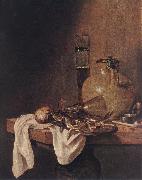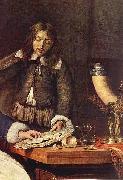
Oil On
Canvas, Real Flavor of Old Masters
|
BEYEREN, Abraham van
|
|||
|
|
|||
| Dutch Baroque Era Painter, ca.1620-1690 Dutch painter. He painted seascapes as well as fruit, flower, fish, game and banquet still-lifes. He almost always signed these works with his monogram AVB, but he dated only a few. This, together with the fact that he painted diverse subjects simultaneously and his style changed little, makes it difficult to establish a chronology. He became a master in The Hague in 1640 and was related by marriage to the fish painter Pieter de Putter (before 1600-59). Van Beyeren lived in Delft from 1657 to 1661 and was again in The Hague between 1663 and 1669. | |||
|
|
|||
|
|
The Breakfast BEYEREN, Abraham van2.jpg Painting ID:: 5178 Visit European Gallery |
Oil on canvas, 74 x 60 cm Pushkin Museum, Moscow | |
Height Width |
INS/CM |
||
|
X |
|
||
|
|
|||
|
Gabriel Metsu
|
|||
|
|
|||
| 1629-1667 Dutch Gabriel Metsu Galleries One of his earliest pictures is the "Lazarus" at the Strassburg Museum, painted under the influence of Jan Steen. In 1653 under the influence of Rembrandt he painted "Woman taken in Adultery," a large picture which is now in the Louvre. To the same period belong the "Departure of Hagar," formerly in the Thore collection, and the "Widow's Mite" at the Schwerin Gallery. But he probably observed that sacred art was ill suited to his temper, or he found the field too strongly occupied, and turned to other subjects for which he was better fitted. That at one time he was deeply impressed by the vivacity and bold technique of Frans Hals can be gathered from Lord Lonsdale's picture of "Women at a Fishmonger's Shop." What Metsu undertook and carried out from the first with surprising success was the low life of the market and tavern, contrasted, with wonderful versatility, by incidents of high life and the drawing-room. In no single instance do the artistic lessons of Rembrandt appear to have been lost upon him. The same principles of light and shade which had marked his schoolwork in the "Woman taken in Adultery" were applied to subjects of quite a different kind. A group in a drawing-room, a series of groups in the market-place, or a single figure in the gloom of a tavern or parlour, was treated with the utmost felicity by fit concentration and gradation of light, a warm flush of tone pervading every part, and, with that, the study of texture in stuffs was carried as far as it had been by Ter Borch or Gerard Dou, if not with the finish or the brio of De Hooch. One of the best pictures of Metsu's manhood is the "Market-place of Amsterdam," at the Louvre, respecting which it is difficult to distribute praise in fair proportions, so excellent are the various parts, the characteristic movement and action of the dramatis personae, the selection of faces, the expression and the gesture, and the texture of the things depicted. Equally fine, though earlier, are the "Sportsman" (dated 1661) and the "Tavern" (also 1661) at the Hague and Dresden Museums, and the "Game-Dealer's Shop," also at Dresden, with the painter's signature and 1662. Gabriel Metsu, Man Writing a Letter (1662-1665), Oil on canvas, National Gallery of Ireland, DublinAmong the five examples of the painter in the Wallace Collection, are "The Tabby Cat," and "The Sleeping Sportsman," which cost Lord Hertford £ 3000, is an admirable example technically considered. Among his finest representations of home life are the "Repast" at the Hermitage in St Petersburg; the "Mother nursing her Sick Child" in the Rijksmuseum in Amsterdam; the "Amateur Musicians" at the Hague Gallery; the "Duet" and the "Music Lesson" at the National Gallery, London, and many more examples at nearly all the leading European galleries. Five of his painting are in Dresden, collected by August the Strong. | |||
|
|
|||
|
|
The Breakfast new25/Gabriel Metsu-556564.jpg Painting ID:: 86049 Visit European Gallery |
1660(1660) Medium Oil on wood cyf | |
Height Width |
INS/CM |
||
|
X |
|
||
|
|
|||








